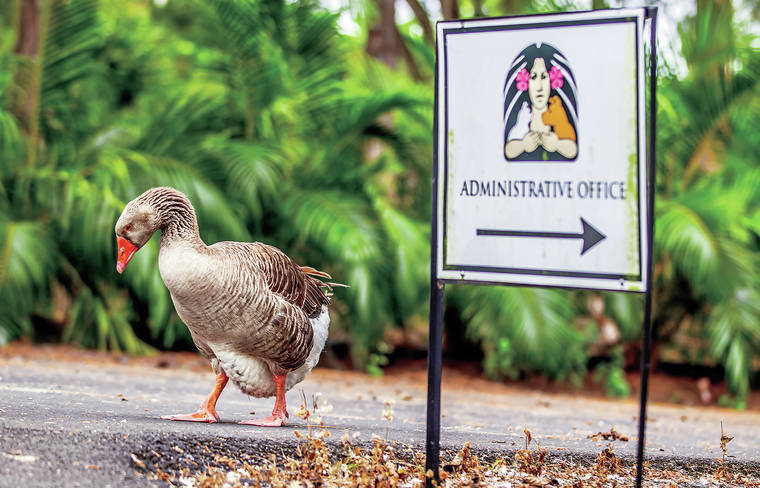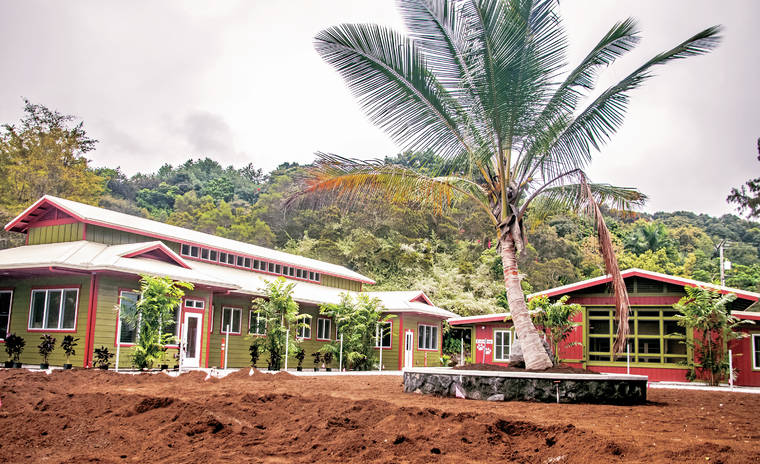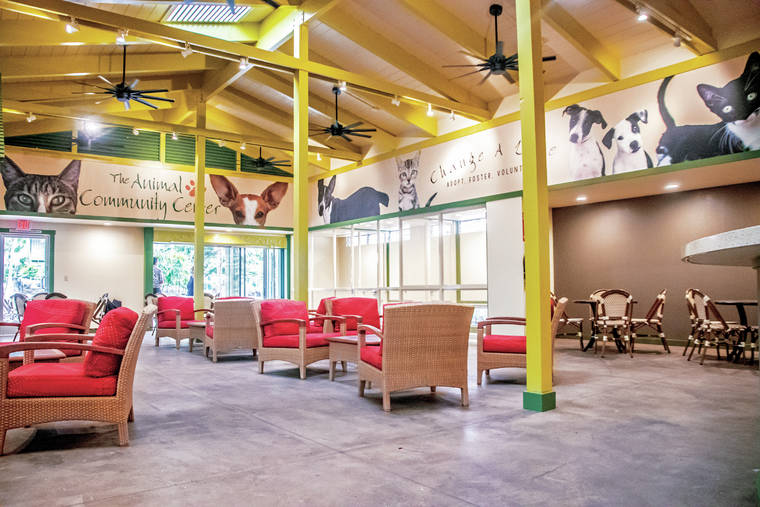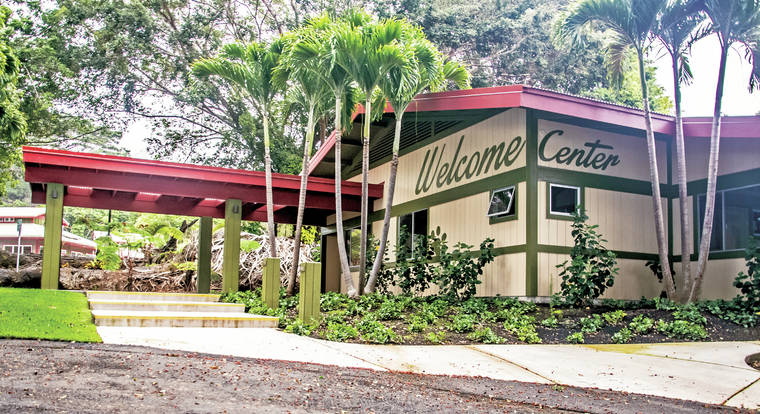Humane Society’s Animal Community Center eyes summer opening

This duck is among the handful of animals who already call the Animal Community Center home. Tom Linder/West Hawaii Today

A lone coconut tree stands in the center of Adoption Square. Visitors will be able to interact with a dog they’re considering adopting in the square that’s near the center of the campus. Tom Linder/West Hawaii Today

Inside the welcome center is a large communal area, with photos of previously adopted animals lining the walls. Tom Linder/West Hawaii Today

The welcome center greets visitors as the enter the Animal Community Center. The Animal Community Center will serve as the new home for the Hawaii Island Humane Society in Kona. Tom Linder/West Hawaii Today
As second phase of its construction nears completion, the Hawaii Island Humane Society’s Animal Community Center is almost ready to be unveiled to the public.
As second phase of its construction nears completion, the Hawaii Island Humane Society’s Animal Community Center is almost ready to be unveiled to the public.
The new campus — spread out over 12 acres at an elevation of more than 1,000 feet along the slopes of Hualalai — boasts a cool climate and state of the art facilities to create an inviting space for animals and humans alike.
“I think my cats might go on strike and want to be here…” joked HIHS CEO Elizabeth Jose. “The feeling of it being a campus and having space for the pets as well as the people to feel comfortable, this is a place that they want to come. Just driving up, you feel like you’re entering a whole new world.”
On a site previously used as both a quarry and botanical garden, Phil Tinguely, the Animal Community Center’s head of construction, found ways to incorporate the property’s past history into the grounds.
“One thing when you’re working in an area that was a quarry: you have a lot of rocks,” said Tinguely, pointing out the decorative boulder piles, retaining walls and dry creek beds created using the repurposed quarry material throughout the campus. “We took a lot of opportunities whenever we had them.”
Entering the campus above the Central Bark Dog Parks, visitors are greeted with a large welcome center. Inside, the walls are lined with mural-sized photos of adopted animals in a large communal area. The space is the first of many indications that the campus is more than just an animal shelter.
“You can imagine in years to come, there could be easily 20, 30 people, there’s a coffee barista here, hanging out, bringing the kupuna up here,” said Tinguely. “They can just relax and settle down.”
Exiting on the opposite end of the welcome center, a gradual slope opens up into what will be a broad grass field with a large coconut tree at the center: Adoption Square. It will serve as a “test-run dog park” where a person can interact with a dog they’re considering adopting in a more protected environment than the Central Bark Dog Parks below.
“We consider this to be, truly, a park…” Tinguely added. “We have these wonderful trees, the topography, we have boulders, and we thought, ‘How can we blend this into the experience?’ And that’s the culmination of what you see.”
Flanked by towering trees that were once the botanical garden, the cat barn and multiple dog dorms that dwarf the Humane Society’s current capacity surround the square. Jose was particularly excited about finally having the space to separate the dogs from the cats, which alleviates problems and allows the animals to be healthier.
“For cats, we are tripling our capacity – before phase three – and for dogs, we’re approximately doubling it,” said Jose. “And when we get phase three done, we’ll double again.”
The areas were designed to be as stress-free as possible for the animals, with consideration given to the interior colors, ventilation, lighting and preferences of each individual animal.
“Different cats like different environments,” said Jose while describing the kennels inside the cat barn. “Some like to hide in small, enclosed spaces; others prefer to be in a bigger environment in groups. Some cats don’t really want to be around other cats.”
The end of the cat barn facing Adoption Square was originally wide open; in an effort to retain the ambiance, ventilation and view while keeping the animals inside, Tinguely and his team turned the side of the barn into a large screen. Building the Animal Community Center was a first for Tinguely; the project has taken more than a decade of planning and work to turn into a place with its own unique feel.
“None of us have built an animal humane society or animal shelter facility before,” said Tinguely. “We relied on an architectural firm out of Colorado that had experience. They gave us the baseline criteria and ergonomics, and we were given the opportunity to take their ideas and apply the practical things they need, but put it in the Hawaiian vernacular.”
While the Animal Community Center will open upon the completion of phase two, work will continue with multiple more buildings, including a vet clinic, a caretaker’s cottage, and several other spaces whose uses will be determined as needs arise.
In the center of the property, Tinguely was confronted with yet another challenge.
“The fire department mandates that you have to have a 20-foot wide solid, hard surface for them to back their fire trucks up. Initially, the engineering had just a big chunk of asphalt here; it looked like half of a basketball court…” he said. “We came to the idea of honoring all the help and benevolence, donating and making this happen. We created a big compass. You have the compass pointing to the animal control center/vet clinic, to the welcome center/cat barn, to the dog park.”
Though the campus, previously estimated to cost $12 million, has not yet opened, it has already proved to be a hospitable place for animals: many chickens and ducks already call the location home. Soon enough — likely this summer — they’ll have to share the Animal Community Center as the HIHS moves their operations from their current location at Hale Makai Place, next to the Kealakehe Transfer Station.
“There’s just no comparison,” Jose said. “It has served us well for years, and we’ve been able to do our work. This is just such an opportunity for us to expand; we’re so excited… This is so much more: more opportunities to provide better service and to be able to invite the community in… It’s a pretty amazing thing to be a part of.”


